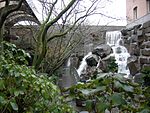The Double Header (Seattle)
1934 establishments in Washington (state)2015 disestablishments in Washington (state)Defunct LGBT drinking establishments in the United StatesLGBT culture in SeattleLGBT drinking establishments in Washington (state) ... and 3 more
LGBT stubsPioneer Square, SeattleWashington (state) stubs

The Double Header was a gay bar located at 407 2nd Avenue S in Seattle's Pioneer Square neighborhood, in the U.S. state of Washington. The LGBT establishment opened in 1934 and closed in December 2015. It was thought to be the oldest gay bar in the United States.In the basement of the building, a gay dance club called The Casino operated from the 1930s to the 1950s; afterwards it was converted into a diner. It was popular with drag queens.
Excerpt from the Wikipedia article The Double Header (Seattle) (License: CC BY-SA 3.0, Authors, Images).The Double Header (Seattle)
Yesler Way, Seattle International District/Chinatown
Geographical coordinates (GPS) Address Nearby Places Show on map
Geographical coordinates (GPS)
| Latitude | Longitude |
|---|---|
| N 47.60114 ° | E -122.3322932 ° |
Address
Interurban Building
Yesler Way
98104 Seattle, International District/Chinatown
Washington, United States
Open on Google Maps








